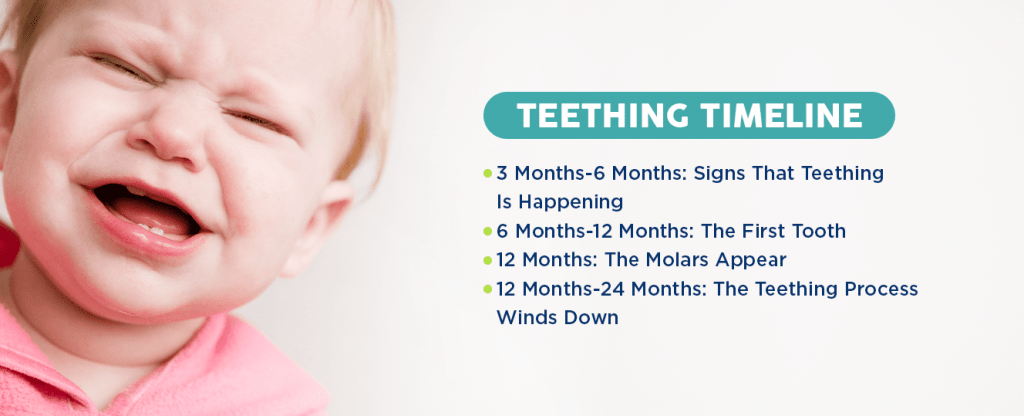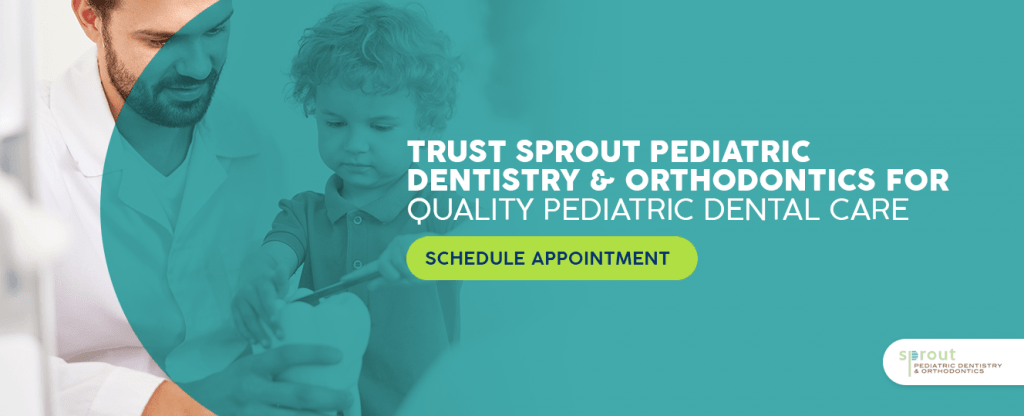Can a Baby Be Teething at 2 Months
When you picture the first year of your baby's life, you probably imagine plenty of smiles, snuggles, milestones and more. And then teething starts. When your child is teething, they can quickly change from a smiling, happy baby into a drooling, cranky mess — all because of that little white tooth trying to break through their ultra-sensitive gums.
On average, babies will get their first tooth around 6 months of age, but there's no specific age babies start teething. Some babies may start feeling the pain and discomfort of teething as early as 3 months. Others may not get their first tooth until closer to their first birthday.
First Signs of Teething
Each child is different, so their responses to the teething phase may vary. If you're wondering "is my baby teething," there are a few symptoms to look out for:
1. Crying and Irritability
One of the most common signs your baby is teething is a noticeable change in their mood. Even the happiest baby may suddenly become irritable. Your little one may cry more frequently or become easily agitated. Typically, this mood shift will be more pronounced in the weeks leading up to the appearance of their first tooth and gradually improve with other subsequent teeth. You may notice they become increasingly irritated again when their molars begin to appear during their second year.
2. Excessive Drooling
Another common sign of teething is excessive drooling. In some babies, this can start as early as 10 weeks of age and continue throughout the teething process. When a baby is drooling due to teething, it's common for them to soak through their shirt (or their parent's shirt) within a short period. No baby or parent wants to spend the day in damp clothing, so many parents use bibs to keep clothing dry throughout the day. Excessive drooling can also cause a rash on the skin around your baby's neck, chin and mouth.
3. Biting
One of the first signs of teething is an increased interest in biting. The pressure the pain creates from a soon-to-erupt tooth can be relieved by applying counterpressure. Instinctively, teething babies will look for things to bite down on to get that counterpressure and relieve their discomfort. You may notice your little one biting anything they can get their hands on. For older babies who already have a couple of teeth, this can be especially painful if they try to bite while nursing.
4. Changes to Eating and Sleeping Routines
Teething is a 24/7 endeavor, which means it impacts all areas of a baby's life. A child who is teething may struggle to nurse or drink from a bottle, as sucking may be painful to teething gums. If they're older, they may refuse solid foods they loved just days before. The pain of teething can also disrupt sleep. Even babies who slept through the night prior to teething may suddenly be more wakeful during the night.
5. Cheek Rubbing and Ear Pulling
A teething baby may pull on their ears or rub their cheeks during the teething process. The ears, gums and cheeks all share the same nerve pathways. That means pain in the jaws from teething may be felt in the cheeks and ears too. These sensations are especially pronounced in babies who are cutting new molars. Because this particular symptom of teething can also be a symptom of an ear infection, it's a good idea to check with your pediatrician if it continues for more than a few days — especially if it's accompanied by other cold or flu-like symptoms like congestion and fever.

Teething Timeline
Your child's teeth begin developing while they are still in utero, but they won't cut through the gumline until several months after they are born. The teething age range varies from baby to baby, but in general, you can expect teething to proceed in this manner:
3 Months-6 Months: Signs That Teething Is Happening
Many parents find their babies begin drooling a lot and showing signs of discomfort as early as 3 months after birth. But that doesn't mean a tooth is about to arrive. In fact, some babies can display signs of early teething and gum sensitivity for several months before a tooth actually appears. During this time, It's important to focus on managing your baby's pain and discomfort while you wait for the tooth to erupt.
6 Months-12 Months: The First Tooth
On average, a child will cut their first tooth around 6 months of age, but it's important to remember that number is an average. Some children get teeth sooner than that, and other children get their first tooth much later. Whatever their age when their first tooth appears, you can expect the first tooth to arrive will be one of the bottom front teeth. Once your baby has cut their bottom incisors, the next teeth to appear will be their four top teeth.
12 Months: The Molars Appear
Around your baby's first birthday, you'll likely notice signs that molars are making their way through the gums. Molars can also be very painful, so parents may notice their baby reverts back to some of their earlier teething symptoms, such as excessive drooling and irritability. Canines — the pointy teeth between incisors and molars, will also appear around this time.
12 Months-24 Months: The Teething Process Winds Down
During your baby's second year, the teething process will primarily involve molars. Young children have two sets of molars, so once the first set appears around age 1, it's time for the second set to make their way through as they approach age 2. Molars tend to be painful because of the broad flat surface breaking through the gums. As with earlier teeth, managing the discomfort is key to getting your baby through this uncomfortable time.
How to Soothe Your Teething Baby
Watching your baby struggle with the discomfort of teething is no fun, but there are some simple things you can do to help ease discomfort:
1. Keep Your Baby's Face and Mouth Dry
All that drool coming from your baby's mouth has to go somewhere. If you leave it on those chubby cheeks and cute outfits, there's a good chance your baby will develop skin irritation. If you don't want to change their clothes often, invest in teething bibs. These bibs can catch the drool and are easy to remove and replace throughout the day. Skin products such as Vaseline and Aquaphor can also be used on their skin to create a moisture barrier and prevent irritation.
2. Utilize Teething Rings and Toys
Teething rings are designed to apply counterpressure that reduces the painful pressure in a baby's gums. Keep a clean supply of these rings around the house and in the diaper bag so you can soothe your baby at home and on the go. Products that can be put in the freezer are even better — the cold numbs their sore gums and provides some additional relief.
3. Consult a Pediatrician
Your child's pediatrician can be a great resource for how to soothe your baby during teething. They can advise you on the best way to use over-the-counter medicines like acetaminophen and non-medicated teething products designed to relieve pain and discomfort.

Trust Sprout Pediatric Dentistry & Orthodontics for Quality Pediatric Dental Care
The American Dental Association recommends a child has their first dental checkup 6 months after their first tooth erupts or by the time they turn 1 — whichever comes first. An early pattern of dental checkups can help ensure your child's teeth are developing correctly and prevent dental problems later in life. At Sprout Pediatric Dentistry & Orthodontics, you'll find a team of experienced dental professionals committed to taking care of your child's teeth and gums every step of the way.
Call today to schedule your child's first pediatric dentist appointment.

Dr. Dana grew up in Portland, and went to Temple University in Philadelphia, PA for dental school. She then moved to Anchorage, AK for her residency in Pediatric Dentistry. Dr. Dana takes a holistic approach to pediatric dentistry & is able to use her own parenting experience to sympathize and understand each family's unique dynamic.
Can a Baby Be Teething at 2 Months
Source: https://www.sproutpediatricdentistry.com/blog/pediatric-dentistry/signs-baby-is-teething/
0 Response to "Can a Baby Be Teething at 2 Months"
Postar um comentário